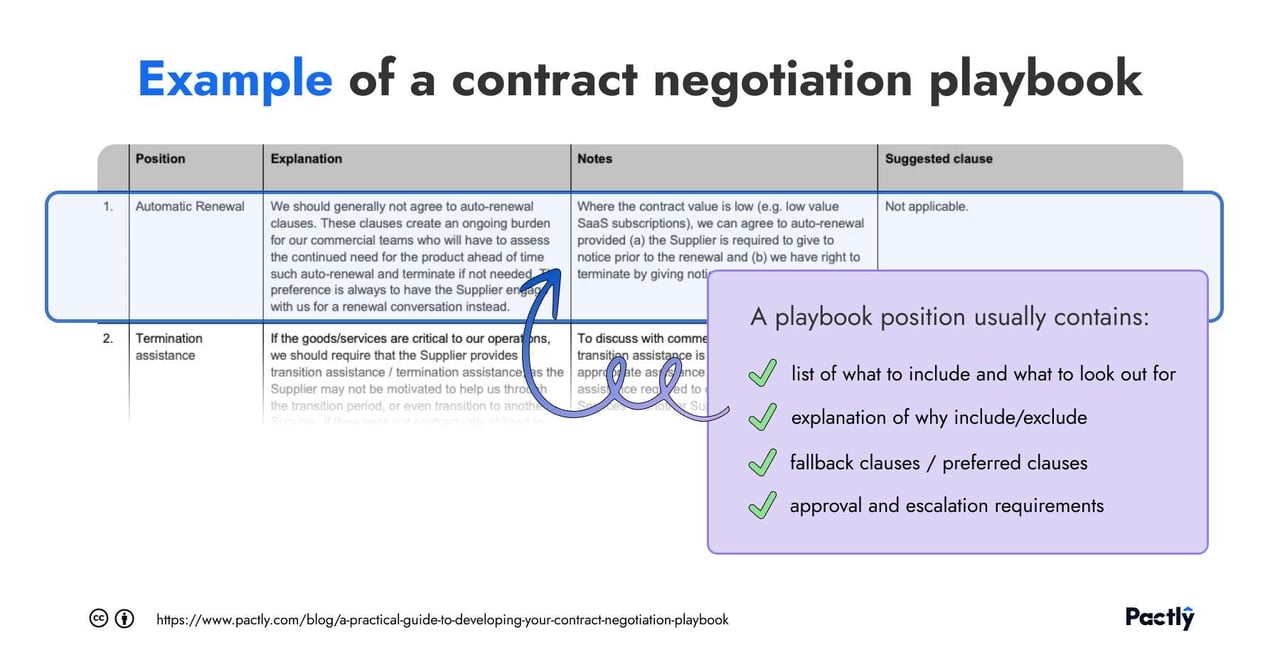A practical guide to developing a contract negotiation playbook
A contract negotiation playbook is a document that outlines the principles and strategies that a company uses when negotiating contracts with other businesses. A contract negotiation playbook offers various advantages to organizations, such as the ability to close contracts faster by streamlining the review and negotiation process. In addition, onboarding new attorneys to the in-house legal department is more straightforward, and legal stakeholders are better aligned with a written articulation of what’s essential in negotiations.
Contract Playbook Basics
What is a Contract Negotiation Playbook?
A contract negotiation playbook is a document that outlines your company’s approach to contract negotiations. It should be part of every organization's contract lifecycle management.
It typically includes information on the following:
- sample language and context around what to include and what to look out for
- usually broken down into must-haves, good to-haves, and can’t have or some form of red/yellow/green colour coding
- deal breakers
- fallback clauses
- approved deviations
- approval or escalation process where there is significant pushback
.jpg?width=1800&height=945&name=Playbook%20Example%20(desktop).jpg)
.jpg?width=1200&name=Playbook%20Example%20(mobile).jpg)
Who will be using the contract playbook?
Contract negotiation playbooks should be used by all team members involved in contract negotiations. Typically, we work with in-house lawyers to develop these negotiation playbooks. However, the end users of these contract playbooks include those who represent the company to negotiate (e.g. sales teams, sourcing/purchasing teams, HR teams) and those who support these representatives (e.g. contract administrators, managers, tax and finance specialists, etc.).
Why do we need a contract negotiation playbook?
Benefits of using a contract playbook
There are many benefits to having a contract negotiation playbook, including the following:
- First, having a contract playbook can help to save time and money by standardizing the negotiation process and ensuring that all of the company’s negotiators are using the same approach.
- Second, a contract playbook can help to improve the average outcomes of the company’s negotiations by providing a framework for identifying and addressing potential problems.
- Third, contract playbooks can be a helpful training tool for new negotiators, helping them quickly learn the company’s approach to contract negotiations.
- Finally, having a contract playbook can promote greater alignment between legal and the other business teams, as everyone will be on the same page regarding the non-negotiables.
.jpg?width=1800&height=945&name=Benefits%20(desktop).jpg)
.jpg?width=1200&name=Benefits%20(mobile).jpg)
Contract playbooks are for larger legal departments; we don’t have the resources.
A common misconception is that contract playbooks are only relevant for large legal teams. However, contract negotiation playbooks can also be extremely useful for small legal teams. Specifying how to review and negotiate your contracts means that you can delegate the contract review to more junior legal team members, your sales reps or the business units. This benefit may be incredibly impactful for smaller legal departments where the senior lawyers are always pressed for time.
You’re probably thinking, “Sounds great, but we don’t have the time to prepare a playbook?”. That’s a real challenge; you will have to set aside some time if you wish to create one. If you are looking for a shortcut, you can also check out our contract playbook template for small legal teams, which will give you a starting point for the most common contract types (non-disclosure agreements, confidentiality agreements, service agreements, sales agreements, consulting contracts and more). Also, in the next section, we will show you how you can easily create a contract playbook.
Five practical steps to build a robust contract playbook
Creating a contract negotiation playbook does not have to be a complicated or time-consuming process. The steps below provide a quick guide to creating a contract playbook. Don’t worry; the first version doesn’t need to be perfect since you’ll have to review the playbook frequently and update it anyways (more on this later).
Step 1: Setting the scope and the boundaries
You’ll want to start by defining what this contract playbook should cover:
- What contract type is covered by the contract playbook? Do you need multiple contract playbooks for the different contract types?
- Should it be limited to high-risk contracts or contracts above a certain dollar value threshold?
- Does it apply to contracts on third-party paper, or does it also apply to your contract templates?
- Will you use the playbook internally for your legal department, or will you involve your sales, HR, procurement, or other business teams in using the contract playbook?
A quick tip: If you’re unsure where to start, we recommend going to your inbox, filtering your emails to the last 30 or 60 days, and seeing who your biggest requesters/internal stakeholders are and the contracts being heavily negotiated. That will give you an idea of where to start :)
Step 2: Prelim research on the positions (commonly negotiated clauses)
Next, you’ll want to list all the commonly negotiated clauses in that contract type. If you’re having trouble writing out this list, you can always get feedback from your business unit on which clauses they have frequently been negotiated. Another quick hack is to Google “Top 10 issues in [contract type]”, and you’ll probably find a bunch of resources. You don’t have to read everything since the idea is to brainstorm ideas of the common points of negotiations.
From here, you’ll want to order these positions from most important to least important. This helps you prioritize the level of detail you should go into.
Step 3: Flesh out the positions
With your list of positions, we’d recommend going through each position and following this rough structure to write out 1 - 2 lines per bullet point below for each position. Here’s an example to explain what we mean:
.jpg?width=1800&height=945&name=Breakdown%20of%20a%20positon%20(desktop).jpg)
.jpg?width=1200&name=Breakdown%20of%20a%20position%20(mobile).jpg)
Position name:
- A short, identifiable name usually referencing the concept or clause
Explanation:
- 1 - 2 sentences about why this is important, why we need to have it or why we can’t accept it.
- Explanations can be handy since you can copy and paste them into your comments to the counterparty later.
Guidance notes:
- We find it helpful to go one step deeper than the explanation here.
- Suppose the explanation was about why we need to have a particular clause or exclude a specific clause. In that case, the notes should cover (a) when an exception to this position could be permissible, (b) what factors might change the position (e.g. value at risk, industry/sector/vertical etc.), (c) how to communicate this to the counterparty, and (d) who to approach if there is a need to escalate.
- Use these probing questions to expand on your guidance notes.
Preferred positions/fall back positions:
- The easy way is to copy the default positions and fallback clauses from your existing contracts (contract templates or even third-party paper), but don’t worry if you don’t have them ready. LawInsider is an excellent resource for searching for all kinds of clauses and contract wording from a database of SEC contracts.
- Also, you can leave them blank for now and deal with creating defaults and fallbacks as your contract playbook is used more frequently. Remember - done is better than perfect here :)
Pro Tip: If you’re delegating the first review to someone outside your legal team, consider keeping the first version of your contract playbook much shorter. We generally recommend 10 - 12 positions to start things off. Nobody wants to read a 40-page essay on how to review customer contracts :)
Step 4: Socialize and Implement
At this point, you might be tempted to believe that the hard work has been done. Well, that’s only half true. The battle is only won when your team starts using the contract playbook. We’ve seen different teams handle implementation differently. Still, one approach we particularly like is holding a mini road show where you make an event out of the first release of your contract playbook. Invite your stakeholders for a sharing session where you can conduct some training (bonus: find a small budget for food or snacks; it always makes any session better).
If you have a contract management system or some digital contract process, explore how to tap into this process to capture and track if your contract playbook is getting adopted. For example, if your process permits, you could add a question for every new contract review request requiring the requester to select the issues in your contract playbook being negotiated.
Step 5: Review the performance of your contract playbook
We encourage all our customers to be very deliberate about reviewing their contract playbooks.
- Set a date on your calendar, once every 3, 6 or 12 months and invite your stakeholders to these sessions. Collect feedback on what is working and what is not; in particular, keep an eye out for positions your team always seems to be escalating or compromising. It usually indicates something that needs tweaking in the contract playbook.
- Consider auditing a small number (e.g. 3 to 5) of past contracts to see how the contract playbook has been executed. The objective here is not to audit these past contracts for correctness but for confusion. You want to identify parts of the contract playbook that the end users may not understand as well as you had assumed.
Why you should consider using a digital playbook in your contract negotiation process
The most common way to build your contract playbook is in a Microsoft Word document or a Microsoft Excel file. You’re probably already familiar with these solutions, and it likely doesn’t cost you anything. However, there are some advantages to using digital contract playbooks, which include:
- Analogue/document-based contract playbooks get obsolete fast simply because they are more cumbersome to edit
- Changing your playbook is tricky: You’d have to mark up the contract playbook, circulate it and pray that your team reads and internalizes these changes. Using digital contract playbooks, these changes are updated automatically and reflected the next time the user does a contract review.
- Information overload; too much legal language: Sending a 20 - 30 pages document and expecting your sales team, procurement team, HR or finance to read it is hopeful. Unless your business colleagues understand the playbook, driving its adoption can be challenging. Using digital contract playbooks, we can make the experience more user-friendly by only surfacing the relevant guidance and notes to positions the counterparty is negotiating. There’s also an opportunity to use artificial intelligence to simplify reviewing contracts.
- Lose valuable data on each negotiation: Digital contract playbooks allow you to track which positions are being heavily negotiated and understand if you’re conceding too often. If so, perhaps, you need to chat with the team, or maybe the position doesn’t reflect commercial realities and needs to be changed.
.jpg?width=1800&height=945&name=Digital%20Playbooks%20(desktop).jpg)
.jpg?width=1200&name=Digital%20Playbooks%20(mobile).jpg)
Finally, Get Started!
“The hardest part is starting. Once you get that out of the way, you’ll find the rest of the journey much easier.” - Simon Sinek.
A contract negotiation playbook can help your company in many ways. It can save time and money by making the negotiation process more standardized, and it makes it easier to train new legal team members. If you’re interested in exploring how you can build your own playbooks using Pactly to improve your contract review process, feel free to book a demo or if you’re the hands-on type, we offer a free 30-day trial too. Pactly is a modern contract management solution that helps legal teams of all sizes draft, review, negotiate and manage their contracts through our contract management software.
Alternatively, if you're looking for additional resources to help you with contract negotiation, be sure to sign up for our blog. In the coming months, we'll be sharing valuable insights and tips, including free template negotiation playbooks to help you streamline your contract management process. Stay tuned for more updates and helpful resources from our team!


